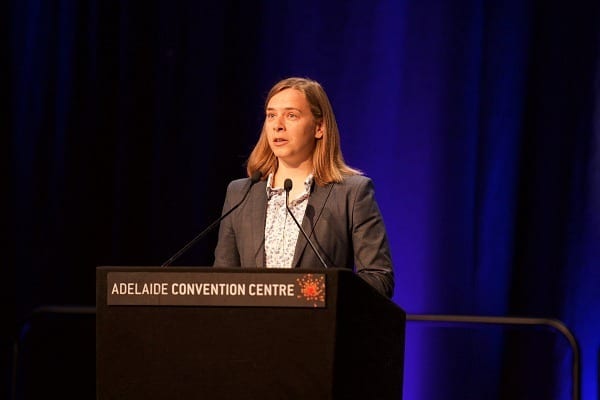The conference, taking place one year after the launch of the STEM Decadal Plan which is meant to serve as Australia’s road map to gender equality in STEM, was an opportunity to take stock, celebrate successes and look for ‘opporSAGEtunities’ to accelerate change.
The conference also coincided with the annual SAGE Awards Dinner, in which 11 higher educational institutions were awarded Athena Bronze accreditation – a symbol of their commitment to and action on gender equity.
That brings the total to forty-five Australian higher education and research institutions that have now completed the SAGE pathway to accreditation, with the majority (39 organisations/86 per cent) being awarded the Athena Swan Institutional Bronze Award.
The vibe amongst delegates was ““action plans” and “strategies” are all well and good, but show us the gender equality”. There was an overwhelming appetite for evaluation and accountability to ensure the landmark strategy delivers on its promises. And, there was discernible impatience with the current rate of change.
Professor Lisa Harvey-Smith, Australia’s inaugural Women in STEM Ambassador and an award-winning astronomer with a research interest in the birth and death of stars and black holes, kicked things off with a keynote address entitled, “Change is a verb”.
“Change is an interesting word,” she said. “To change something, we have to do something. Change is a verb.”
“We need a sustained force over time,” Professor Harvey-Smith added. “It is important that we share our work because that is how we will learn from each other going forward…also how we will hold each other to account.”
Today and tomorrow I’m at the Catalysing Gender Equity 2020 conference in Adelaide. Honoured to give the keynote about what my office @WomenInSTEMAu is doing in this space. Follow the hashtag #CGE2020 for news, comments and updates! pic.twitter.com/YmQP28qfhE
— Prof. Lisa Harvey-Smith (@lisaharveysmith) February 20, 2020
In terms of accountability, Professor Harvey-Smith recounted that when she started in the role as Australia’s Women in STEM Ambassador, she was often asked why Australia’s 300 plus women in STEM programs were not making a difference.
Her theory: we don’t know because too few of these programs are evaluated, a significant gap Professor Harvey-Smith and her office are seeking to remedy with the development of a clear, national evaluation framework to track what’s working – and what isn’t.
Professor Harvey-Smith also recounted a light bulb moment when she attended the European Gender Summit in Amsterdam last year. “One thing I found compelling is that before 2011, Athena Swan was just a nice to have,” she said. “Then in 2011 they announced that in five years’ time, 2016, any academic institution that wanted research funding had to have at least Bronze.”
“Has it worked,” asked Professor Harvey Smith? “It certainly seems to. Is this a model we should adopt in Australia…let’s talk about it?”
Elsewhere at the conference, others offered disruptive ideas to accelerate the pace of change.
On a panel entitled “Stepping up as leaders to drive systems wide change in STEM”, which was chaired by Elizabeth Broderick, Dr Bronwyn Evans, the CEO of Engineers Australia, noted that since 2006 the percentage of women in engineering had increased by just 3 percent to 13%.
“That’s pretty bloody horrible,” said Dr. Evans. “How about putting targets at universities (for the percentage of women studying engineering)…why not?” Dr. Evans added that she would like to see the study of mathematics mandated all the way through secondary school.
Professor Brian Schmidt, the Vice Chancellor of Australia National University, said on the same panel, “There is a lot of goodwill towards gender equity in Australia, but most are ‘would have been, could have been’ champions.”
“Everyone says the right things,” Professor Schmidt added, “but when I come back nothing happens.”
He recounted that at ANU he had created a number of STEM programs with a fifty-fifty split as, “that was the only way I could guarantee it would be a safe space for women.”
Removing names from Australian Research Council grant applications, introducing targets for a fifty-fifty split of funding under the National Health Medical Research Council (NHMRC) funding scheme and creating “women only” roles were also mooted – and hotly debated.
Over the course of the two days, the spectre of backlash, both within the STEM sector and more broadly, was ever present. “We are at a crossroads,” said Elizabeth Broderick, former Australian Sex Discrimination Commissioner and Founder of Male Champions of Change. “We are seeing a major backlash on women’s equality in many parts of the world.”
Alison Johns, Chief Executive of Advance HE, the United Kingdom higher education umbrella body that created and the Athena SWAN program, told the crowd at the SAGE Awards dinner that the fight for gender equality had never been more important. “And I call it a fight because it is,” added Ms. Johns. “Something in the world is happening that is regressive and we can’t let that happen.”
For the hundreds of delegates at the historic conference, there would certainly be no going back – only full speed ahead. And they have their eyes fixed closely on the speedometer.
Kristine Ziwica tweets @KZiwica


